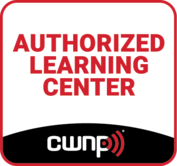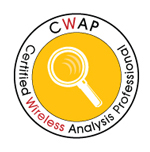 CWAP Course Outline
CWAP Course Outline
Enterprise Wi-Fi Analysis & Troubleshooting, Outline v2.0
Click here to register for this course
Check out our 15th anniversary bundle option! … Click here for the ultimate CWNP bundle.
Introduction
The CWAP Wireless LAN Analysis course consists of hands-on learning using the latest enterprise wireless LAN analysis and troubleshooting tools. This course takes an in-depth look at the functionality of WLANs, intended operation of the 802.11 protocol and Wi-Fi Alliance specifications, WLAN frame formatting and structure, troubleshooting methodology, and protocol analysis. It also includes extensive training in modern spectrum analysis with a focus on advanced RF behavior analysis, data collection methods, interpreting spectrum plots and charts, and understanding advanced features of WLAN spectrum analyzers.
Upcoming classes:
-
Melbourne: 12-14 Nov
Students who complete the course will acquire the necessary skills for analyzing, assessing, and troubleshooting wireless operation in the enterprise, utilizing hardware and software solutions from the industry’s leading manufacturers.
 Associated Certifications: CWAP
Associated Certifications: CWAP- Price: $3,250.00 (ex)
- Duration: 4 days, Classroom, approximately 50% or more hands-on
- Delivery Options : 4 day fast track or 1 day per week over 4 weeks
- Availability: Sydney, Melbourne, Brisbane and Canberra
- Prerequisites: CWNA required
CWAP Course Outline
The following list contains the materials covered in the lecture portion of the course.
Principles of WLAN Communication
- 802.11 Working Group
- OSI reference model and the 802.11 PHY and MAC
- Communication sublayers and data units
- WLAN architecture components
- Organization of station forwarding
- Addressing and internetworking operation
- Modern WLAN product architectures
Physical (PHY) and MAC Layer Formats and Technologies
- Physical layer functions
- Preamble function and format
- Header purpose and structure
- Analysis of PHY problems
- Physical PPDU formats
- 802.11b
- 802.11a
- 802.11g
- 802.11n
- MAC frame components
- MAC encapsulation
- Fields and subfields of the MAC header
- Frame Control
- Frame types and subtypes and their uses
- Addressing
- Frame body
- Data frame format
- Control frame format
- Management frame format
- Information elements and fields
Protocol Operation
- Beaconing and synchronization
- Scanning
- Client state machine
- 802.11 contention
- QoS
- Admission control
- Band steering and airtime fairness mechanisms
- Fragmentation
- Acknowledgments and Block acknowledgments
- Protection mechanisms and backward compatibility
- Power management
- Dynamic Frequency Selection (DFS) and Transmit Power Control (TPC)
- Security components, methods, and exchanges
- Roaming procedures exchanges
- Future protocol enhancements
802.11n
- Transmit beamforming
- Spatial multiplexing
- Maximal Ratio Combining (MRC)
- Space-Time Block Coding
- 40 MHz channels
- Frame aggregation
- HT-OFDM format
- Modulation and Coding Schemes (MCS)
- HT frame formatting
- And More
Protocol Analysis Tools and Methodology
- Troubleshooting methodology
- Protocol analyzer types
- Analysis NIC/adapter selection and constraints
- Interpreting results based on location
- Analyzer settings and features
- Filtering and channel scanning
- Interpreting decodes
- Using advanced analysis features
- Assessing WLAN health and behavior factors
- Evaluating network statistics
- Troubleshooting common problems
- Wired analysis to support wireless network issues
Spectrum Analysis Tools and Methodology
- Radio frequency behavior review
- Visualizing RF domains using spectrum measurement tools
- Spectrum analyzer types and operation
- Analyzer specifications and characteristics
- Understanding spectrum data presentation
- Interpreting plots and charts
- Common WLAN spectrum analyzer features
- Identifying transmit patterns
- Device classification and network impact
- Recognizing transmit signatures
Hands-on Lab Exercises
Protocol Analyzer Setup, Use, and In-Depth Analysis
Using a WLAN protocol analyzer is a fundamental piece of network troubleshooting. In this course, protocol analysis is the foundation for hands-on learning, as students will use these tools to gain familiarity with and exposure to analyzer features and use, frame formats, and protocol operation.
This lab set (10 labs) is focused on gaining familiarity with analysis tools, using them to capture traffic, and interpreting the frame traces:
- Basic installation and familiarity with capabilities, configuration, and data display
- Opening, collecting, saving, and modifying capture files
- Exploring common features like device naming and prioritization, filtering traffic, and using coloring rules as analysis aides
- Configuration of the tool to perform live captures based on a set of desired collection criteria
- Identifying significant network behaviors, metrics, and statistics used to identify and isolate network problems
- Using expert features of the analyzer, such as conversation analysis
- Remote packet capture with an AP
Understanding Frame Components
This lab set (9 labs) is focused on using analysis tools to capture and visualize the 802.11 frame types, uses, and formats first hand. Familiarity with the frame structure and contents is essential in real-world troubleshooting efforts, and this lab is designed to provide that familiarity so that both normal behavior and problematic behavior can be identified. Areas of focus include:
- Understanding the MAC header
- Comparing the three major frame types and their subtypes
- Analyzing frame formats of individual frame types
- Analyzing 802.11n frame components
- Identifying what additional information is reported by protocol analyzers
- Understanding what information is not visible in protocol analyzers
Frame Exchanges
In addition to understanding the frame types and formats in WLANs, it is essential to know how and when each frame is used in interactive communication. Understanding frame exchange rules and behaviors is critical to identifying expected and unexpected. It is also necessary to understand what is normal so that aberrations can be properly troubleshot. This lab is focused on observing and explaining WLAN behavior using a protocol analyzer. The following will be covered in this lab exercise:
- Connectivity exchanges and sequences
- Legacy and modern security exchanges
- ERP and HT protection mechanisms
- Power save behavior
- Acknowledgments, block acknowledgments, and supporting action frames
- Dynamic rate switching
- Band steering
- And more
Troubleshooting Common Problems
This lab exposes students to hands-on troubleshooting skills by setting up common problems in WLANs and allowing students to attempt to solve them.
- Troubleshooting connectivity exchanges
- Troubleshooting 802.1X and EAP exchanges
- Troubleshooting roaming
Spectrum Analyzer Setup, Use, and In-Depth Analysis
This lab section is focused on gaining confidence and familiarity with spectrum analyzers. Specifically, it will explore the plots and charts used to display spectrum data and how to interpret this data to define a transmitter’s impact on the network. The following steps will be covered in this lab exercise.
- Installing the analyzer and becoming familiar with display and navigation
- Understanding the “RF perspective” provided by each plot and chart
- Using built-in features like markers and traces as well as automated device identification
- Characterizing the behaviors of an interference source
- Assessing the impact of an interference source
- Determining the impact of transmitter proximity on interference and spectrum displays
- Identifying signatures of common transmitters
- Remote spectrum analysis with an AP
